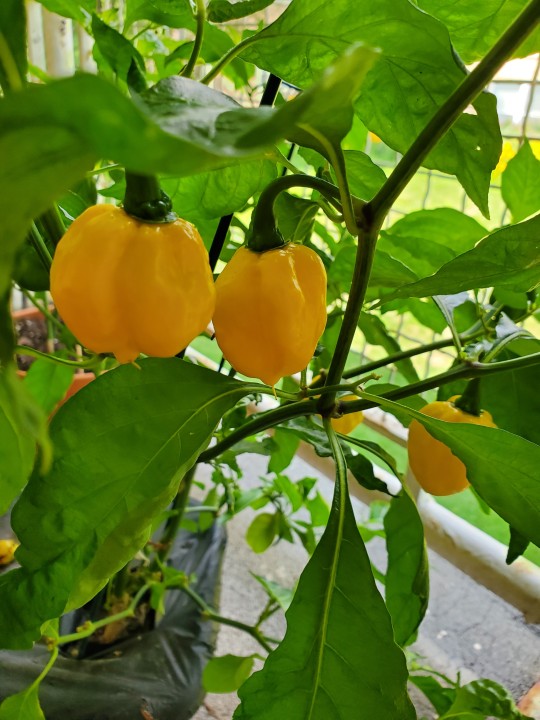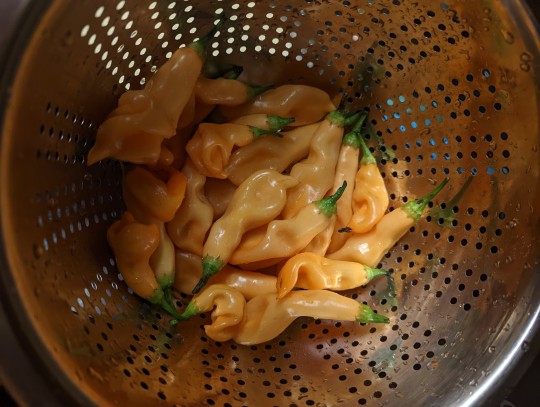#Capsicum Chinense
Explore tagged Tumblr posts
Photo

I hand you these peppers, what do you do?
#my photos#my plants#capsicum chinense#pepper#Pimenta Itagiba Habanero Amarelo#i just think they look neat
0 notes
Text
Six on Saturday 06/01/2023

View On WordPress
#Alma Paprika plant#Black Pepper plant#Capsicum annuum#Jamaican Scotch Bonnet Pepper &039;Capsicum chinense&039;#Meilland roses#Meilland Top Cream#paprika#Pcv. Key Lime Stars#Piper nigrum#six on saturday#Top Cream Rose
0 notes
Text
Taking a break from my usual prairie plants to show you one of my other favorites, genus Capsicum

This plant is a hybrid of C. annuum and C. chinense
The peppers just started getting ripe this week and they smell amazing, spicy but also sweet and fragrant
2 notes
·
View notes
Text
Hot Pepper Seeds - Scotch Bonnet Pepper seeds -Canada grown heirloom non GMO vegetable - Spicy Pepper seeds Capsicum chinense
Package of about 10 seeds from Scotch Bonnet Peppers – Open pollinated vegetable seeds (it’s actually a fruit!)- non sprayed – non GMO – harvested from our gardens in Nipissing and Waterloo Regions Ontario. Scotch bonnet pepper seeds – famous for flavouring Jamaican food. They have a Scoville rating of 100,000 to 350,000 – which is pretty darned hot. Scotch bonnets are also known as Bonney…
0 notes
Text
Csípős paprika ritkaságok az Egzotikus Növények Stúdiója kínálatában. Csípős paprikák - Aji Dulce Amarillo chili
Különleges fűszernövények az Egzotikus Növények Stúdiójától Különleges zölds��g magok (paradicsom, paprika, tök, uborka, bab, dinnye), varázslatos virágok. - Aji Dulce Amarillo chili - Capsicum chinense https://www.egzotikusnovenyek.hu/hu/csipos-paprikak/aji-dulce-amarillo-chili-detail #egzotikus, #különleges, #növények, #mag, #vetőmag, #paprika, #csípős

0 notes
Text
https://gardenersschool.com/chili-plants/
Chili plants (Capsicum spp.) are a favorite among gardeners for their vibrant colors, diverse flavors, and the fiery kick they add to dishes. Growing chili plants can be a rewarding experience, whether you're an experienced gardener or a beginner. This comprehensive guide covers everything you need to know to successfully grow and care for chili plants, from planting to harvest.
Overview of Chili Plants
Chili plants come in various species, with Capsicum annuum, Capsicum frutescens, and Capsicum chinense being the most commonly cultivated. These plants vary in heat level, size, and color, offering a wide range of options for your garden and kitchen.
#indoor plants#plants#gardening#garlic#gardenersworld#garden#gardevoir#gardeners on tumblr#planting#indoor garden
0 notes
Text

Devilish chili habanero holder by LaProve.com
The Habanero Chocolate chili pepper comes from the state of Michoacan in central Mexico. It is characterized by dark fruits and a high heat of 570,000 SHU. From the Capsicum chinense jacq series. native to Mexico, known as the black habanero. This is an ancient variety. Black habanero has an exotic and unusual flavor and is hotter than regular habanero s rating between 400,000 and 600,000 Scoville units. Food name: Chilli Chocolate Net amount: 2g Ingredients: chili chocolate. Country of origin: Czech Republic Amount of main ingredient in percentage: 100%
0 notes
Text
Ghost peppers, also known as Bhut Jolok... https://garvillo.com/how-do-i-identify-a-ghost-pepper/?feed_id=391&_unique_id=6568f7f125a33
0 notes
Text
Estimation of genetic variation in yield, its contributing characters and capsaicin content of Capsicum chinense Jacq. (ghost pepper) germplasm from Northeast India
http://dlvr.it/SrPqpn
0 notes
Photo

🌶 2023 Pepper Grow 🌶 🙌 🔥 Orange Reaper ▫️Chinense ▫️Origin: USA ▫️SHU: ~ 2,000,000 The Orange Reaper Pepper plant is a cultivar of the Carolina Reaper pepper, which is known to be one of the hottest peppers in the world. Here are some highlights of the Orange Reaper Pepper plant: ▫️Origin: It is believed to have been developed through selective breeding, with the goal of creating a pepper with a more vibrant and attractive color. ▫️Heat: The Orange Reaper Pepper is extremely hot, with a Scoville rating of over 2 million. This makes it one of the hottest peppers in the world, and not for the faint of heart.A ▫️Appearance: As the name suggests, the Orange Reaper Pepper is orange in color and has a distinctive wrinkled appearance. The peppers are small and typically range from 1 to 2 inches in length. ▫️Growing conditions: The Orange Reaper Pepper plant is a relatively easy plant to grow, but it does require a warm and humid environment. It does best in full sun and requires regular watering and fertilization. ▫️Culinary uses: While the Orange Reaper Pepper is incredibly hot, it can be used in cooking to add heat and flavor to dishes. It is often used in hot sauces, marinades, and spicy dishes like chili. #garden #fresh #gardening #spicy #plantsmakepeoplehappy #jardin #growyourown #growyourownfood #freshflowers #gardeninspiration #peppers #spicyfood #hotsauce #freshfruit #gardensofinstagram #backyardgarden #homegarden #gardenphotography #hotstuff #jardineria #growsomethinggreen #ediblegarden #habanero #chilis #gardenlover #hotpeppers #capsicum #chillies #carolinareaper https://www.instagram.com/p/Cp-p7Fcp09j/?igshid=NGJjMDIxMWI=
#garden#fresh#gardening#spicy#plantsmakepeoplehappy#jardin#growyourown#growyourownfood#freshflowers#gardeninspiration#peppers#spicyfood#hotsauce#freshfruit#gardensofinstagram#backyardgarden#homegarden#gardenphotography#hotstuff#jardineria#growsomethinggreen#ediblegarden#habanero#chilis#gardenlover#hotpeppers#capsicum#chillies#carolinareaper
0 notes
Text
I think I sincerely know the answer to this question, or part of it. Cultivated peppers come in five species of the genus Capsicum. Everybody knows Capsicum annuum, perhaps the best distributed, responsible for bell peppers, jalapeno, serrano, shishito, aleppo, and the Korean peppers in gochugaru. Three are much less common. C. frutescens has a small handful of species, most recognizabe in North America is Tabasco; C. baccatum has like three cultivars; C. pubescens at least according to wikipedia is localized to Peru.
The last species is Capsicum chinense. This is where almost all of the absurdly hot peppers come from. Habanero, Scotch bonnet, ghost pepper, Trinidad scorpion, Carolina reaper are all cultivars of chinense, which makes them close siblings compared to their cousin jalapeno. I do not know why they are wrinkly, but one possible reason they are (usually) small because they have more flowers per fruit node than C. annuum (which typically has one flower per fruit node) and crowd each other. If they got too big, they'd be more likely to break the stem they're all growing off of. Here is a chinense image with two flowers from the same node. They can grow up to five.

why are the hottest peppers all small and wrinkly . U know that thing's going to fuck you up when it looks like someone's shrivelled nutsack
281 notes
·
View notes
Text
Full pepper harvest, November 6th, 2022.


Top to bottom, left to right clockwise:
Bubblegum White, Numex Suave Orange, Yellow Reaper, Aji Norteno, Murasaki Purple, Sugar Rush Peach, Tobago Seasoning, Cheiro Roxa, Pink Tiger Yellow, White Ghost mix, Pimenta De Neyde, Aji Mango Stumpy, Purple Reaper, White Chuphentino.
90% Capsicum Chinense, with a few Capsicum Baccatum (Aji Norteno, Sugar Rush Peach, Aji Mango Stumpy) and one single solitary Capsicum Annuum (Murasaki Purple).
Ranging from sweet to Superhot, most being in the middle.
#gardening#gardenblr#solanacae#no id to be added later#Peppers#hot peppers#Capsicum Chinense#Capsicum#Capsicum Baccatum#Capsicum Annuum#chili
46 notes
·
View notes
Text
Különleges padlizsánok az Egzotikus Növények Stúdiójától. Csípős paprikák - Yellow fire chili
Bámulatos növény szimfóniák a világból Tekintse meg egzotikus növény kínálatunkat, melyben számtalan lenyűgöző ritkaságot találhat. - Yellow fire chili - Capsicum chinense https://egzotikusnovenyek.hu #egzotikus, #különleges, #növények, #mag, #vetőmag, #paprika, #csípős

0 notes
Video
youtube
Capsicum lanceolatum | A very rare pepper species Here is the Capsicum lanceolatum, Scoville Units: 0 to 600 SHU. After more than 50 years, the rare autochthonous species, Capsicum lanceolatum, of Mesoamerica was rediscovered in a virgin remnant of the Guatemala cloud forest.
#Acı Biber Pepper#AJI#Aji Charapa#aji charapita#Aji Rainforest Pepper#Ancho Chile Pepper#Black Bhutlah Pepper#Black Scorpion Pepper#Candlelight Mutant Pepper#Cap 501 pepper#Capsicum annuum#Capsicum annuum var. annuum#Capsicum baccatum#Capsicum chacoense#Capsicum chinense#Capsicum flexuosum#capsicum plant#caring for chilli plants#Charapilla#CHILI#chili pepper plant care#chili plant#CHILIS#CHILLI#chilli plant#chilli plant care#CRX Fatalii Pepper (HR)#garden#gardenia#gardening
3 notes
·
View notes
Text
the suffix -ensis or -ense means “from that location,” such as in the case the American alligator, Alligator mississippiensis = “Alligator from Mississippi.”
like the alligator, or the fungus you refer to, location-based scientific names don’t necessarily mean they’re restricted to that location or that they even naturally occur there at all! Capsicum chinense is the binomial name for the habanero pepper, but the plant is native to the Americas. the Dutch botanist who named it in 1776 got confused because European explorers had already introduced the plant to Asia, where it became a very popular and common crop. and once a scientific name is made, it can’t be changed for any reason other than taxonomy (e.g. someone else described it under a different name already). there’s a lot of these out there—Vespula pennsylvanica is a good one: it’s the Western Yellowjacket, and it doesn’t occur in the eastern half of the US at all.
I’m assuming both the arachnid and fungus P. cubensis were named because that’s where they were first collected, but there could be other good reasons as well. my advice is to not always read too closely into the binomial names—sometimes they are nice and descriptive, but other times they can be quite misleading if you don’t know anything else about the animal.

a male Paraphrynus cubensis I found under some junk in a Miami parking lot.
435 notes
·
View notes
Text
Plant people!!
Does anyone know when the best time is to sow capsicum chinense? (habanero type) I'm thinking about early February.
5 notes
·
View notes